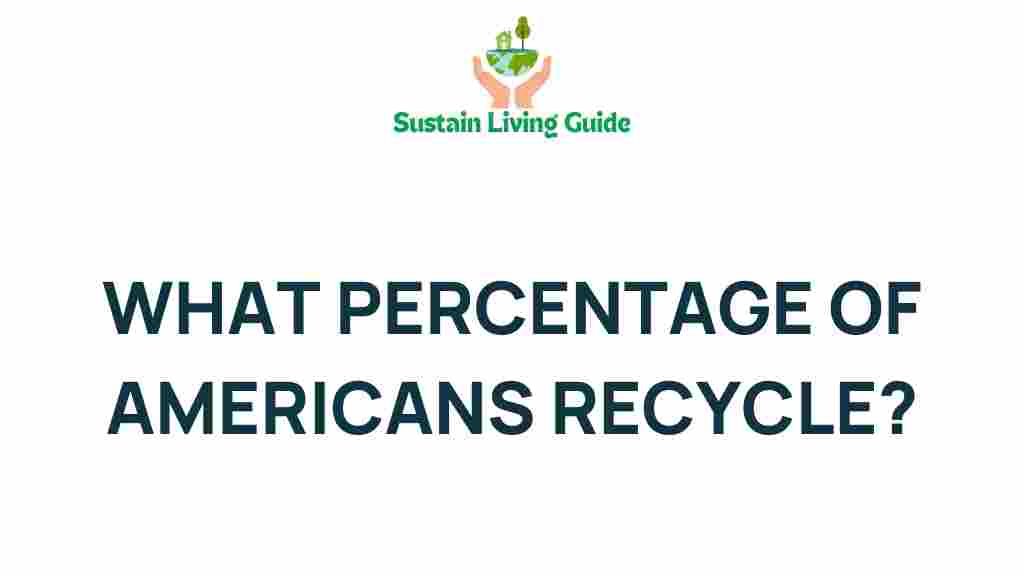Recycling Statistics: Unveiling the Truth About American Recycling Rates
Recycling has become a significant topic in discussions surrounding environmental sustainability. With growing concerns about waste management and climate change, many Americans are increasingly motivated to recycle. But how many actually do? In this article, we will explore the latest recycling statistics in the United States, revealing the truth about recycling rates, the factors affecting them, and what individuals and communities can do to improve their recycling practices.
The Current State of Recycling in America
According to the Environmental Protection Agency (EPA), the national recycling rate in the United States has seen fluctuations over the years. As of the latest figures, approximately 35% of waste is recycled. This statistic illustrates a mixed picture where some regions excel while others lag significantly behind. This section will delve into the statistics surrounding recycling in various demographics and regions.
National Recycling Rates
The national average recycling rate of 35% encompasses a wide array of materials, including:
- Paper and cardboard
- Glass
- Plastic
- Metals
- Organic waste
These categories contribute differently to the overall recycling statistics, with paper and cardboard leading the way. In fact, paper recycling rates can be as high as 66%, indicating a strong public awareness in this area.
State-by-State Analysis
Recycling rates vary significantly from state to state. For instance:
- California: Approximately 50% recycling rate
- Vermont: Near 50% recycling and composting
- New York: Around 30% recycling rate
- Texas: Approximately 17% recycling rate
These statistics highlight that while some states are leading in recycling initiatives, others are falling behind, which raises questions about local policies and educational outreach.
Demographic Factors Influencing Recycling Rates
Several demographic factors can influence recycling behaviors, including:
- Age: Younger individuals tend to recycle more than older generations.
- Education: Higher education levels correlate with increased recycling rates.
- Income: Higher-income households are often more involved in recycling programs.
Understanding these factors can help tailor recycling programs to engage various community segments effectively.
Challenges in Recycling: What’s Holding Americans Back?
Despite the positive strides in recycling, various challenges hinder more widespread participation. Here are some common barriers:
1. Lack of Awareness
Many individuals are unaware of what can and cannot be recycled. Misconceptions about recycling can lead to contamination in recycling bins, making entire batches unrecyclable.
2. Inconsistent Recycling Guidelines
Recycling rules vary greatly between municipalities. The confusion around different recycling guidelines can dissuade people from recycling altogether.
3. Limited Access to Recycling Facilities
In some regions, especially rural areas, access to recycling centers can be limited. This lack of access makes it challenging for residents to recycle effectively.
How to Improve Recycling Rates: A Step-by-Step Process
Improving recycling rates requires a concerted effort from individuals, communities, and local governments. Here’s a step-by-step process:
Step 1: Educate the Community
Education is key to improving recycling rates. Local governments and organizations can:
- Host workshops on recycling practices.
- Distribute informative materials outlining what can be recycled.
- Create engaging campaigns through social media.
Step 2: Standardize Recycling Guidelines
Standardizing recycling guidelines across municipalities can reduce confusion. Local governments can:
- Implement uniform recycling symbols.
- Provide clear labeling on recycling bins.
- Develop a centralized online resource for recycling information.
Step 3: Increase Accessibility
Ensuring that all residents have easy access to recycling facilities is crucial. Possible actions include:
- Expanding curbside recycling services.
- Establishing more drop-off locations for recyclables.
- Creating community recycling events to encourage participation.
Step 4: Incentivize Recycling
Providing incentives can motivate individuals to recycle more. Options include:
- Implementing deposit return schemes for bottles and cans.
- Offering discounts on utility bills for households that recycle regularly.
- Recognizing and rewarding communities with high recycling rates.
Troubleshooting Common Recycling Issues
Even well-intentioned recycling efforts can hit roadblocks. Here are some common issues and solutions:
Problem: Contaminated Recycling Bins
Contamination occurs when non-recyclable items are placed in recycling bins, leading to entire loads being sent to landfills.
Solution:
Implement educational campaigns that clearly explain what items are recyclable. Provide visual guides on recycling bins.
Problem: Low Participation in Recycling Programs
Many residents may still not participate in recycling programs, even when they are available.
Solution:
Engage the community through fun events, competitions, or challenges to motivate participation. Highlight the environmental impact of recycling in local news.
Problem: Lack of Recycling Facilities
Some areas may not have adequate recycling facilities, especially in rural locales.
Solution:
Advocate for local governments to invest in recycling infrastructure and promote regional partnerships to create mobile recycling units.
Conclusion: Embracing a Recycling Future
Understanding the recycling statistics is crucial for assessing the effectiveness of current recycling programs in America. While the national average recycling rate is 35%, there is enormous potential for growth. By addressing the barriers to recycling, increasing education, and improving accessibility, Americans can significantly enhance their recycling efforts. The future of our environment depends on it.
For more resources on recycling initiatives, check out this comprehensive guide. Together, we can work towards a more sustainable future.
Finally, remember that every little effort counts. Whether you’re recycling at home or advocating for better policies, your actions contribute to a cleaner, greener planet.
This article is in the category Waste and created by SustainLivingGuide Team

1 thought on “Unveiling the Truth: What Percentage of Americans Actually Recycle?”